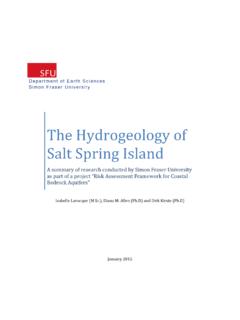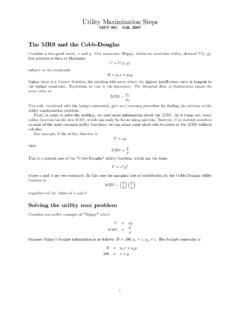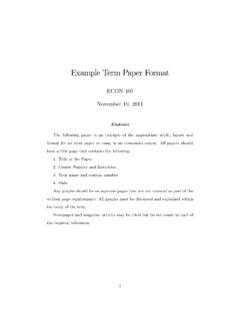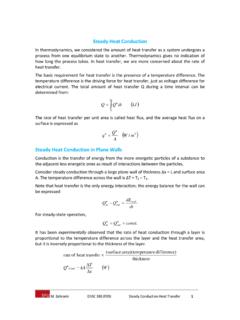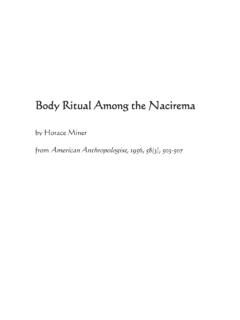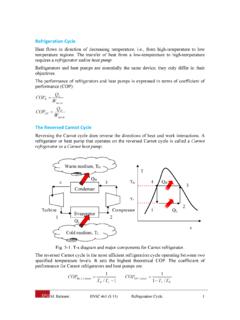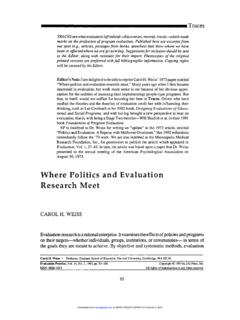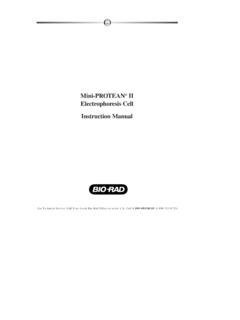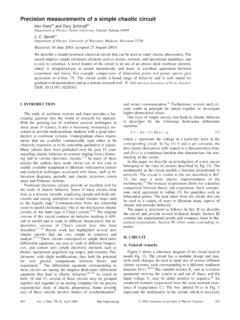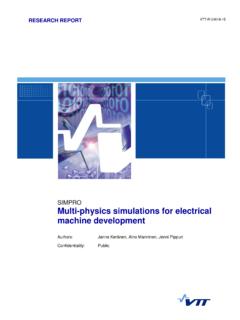Transcription of Natural Convective Heat Transfer from Interrupted ...
1 Natural Convective Heat Transfer from Interrupted Rectangular Fins by Golnoosh Mostafavi B. Sc., University of Tehran, 2010 THESIS SUBMITTED IN PARTIAL FULFILLMENT OF THE REQUIREMENTS FOR THE DEGREE OF MASTER OF APPLIED SCIENCE in the School of Engineering Science Faculty of Applied Sciences Golnoosh Mostafavi 2012 SIMON FRASER UNIVERSITY Fall 2012 All rights reserved. However, in accordance with the Copyright Act of Canada, this work may be reproduced, without authorization, under the conditions for Fair Dealing. Therefore, limited reproduction of this work for the purposes of private study, research, criticism, review and news reporting is likely to be in accordance with the law, particularly if cited appropriately. ii Approval Name: Golnoosh Mostafavi Degree: Master of Applied Science Title of Thesis: Natural Convective heat Transfer from Interrupted rectangular fins Examining Committee: Chair: Dr.
2 Siamak Arzanpour Assistant Professor of Engineering Science _____ Dr. Majid Bahrami Senior Supervisor Associate Professor of Engineering Science _____ Dr. John Jones Supervisor Associate Professor & Acting Director School of Engineering Science _____ Dr. Ash Parameswaran Internal Examiner Professor of Engineering Science (Burnaby) Date Defended/Approved: November 29, 2012 iii Partial Copyright Licence iv Abstract Heatsinks are widely used in various industrial applications to cool electronic, power electronic, telecommunications, and automotive components. Those components might be either high-power semiconductor devices, , diodes, thyristors, IGBTs and MOSFETs, or integrated circuits, audio amplifiers, microcontrollers and microprocessors. More precisely, the passive cooling heatsinks are widely used in CPU cooling, audio amplifiers and power LED cooling.
3 In the work herein, steady-state external Natural convection heat Transfer from vertically-mounted rectangular Interrupted finned heatsinks is investigated. After regenerating and validating the existing analytical results for continuous fins, a systematic numerical, experimental, and analytical study is conducted on the effect of the fin array and single wall interruption. FLUENT and comsol multiphysics software are used in order to develop a two-dimensional numerical model for investigation of fin interruption effects. To perform an experimental study and to verify the analytical and numerical results, a custom-designed testbed was developed in Simon Fraser University (SFU). Results show that adding interruptions to vertical rectangular fins enhances the thermal performance of fins and reduces the weight of the fin arrays, which in turn, can lead to lower manufacturing costs.
4 The optimum interruption length for maximum fin array thermal performance is found and a compact relationship for the Nusselt number based on geometrical parameters for Interrupted walls is presented using a blending technic for two asymptotes of interruption length. Keywords: Natural convection; air cooling; thermal management; heat Transfer ; fluid flow; numerical modeling; heatsink design; experimental study; passive cooling; electronic cooling; power electronics; modeling v Executive Summary Heatsinks are widely used in various industry applications to cool down electronic components. Those components might be either high-power semiconductor devices, , diodes, thyristors, IGBTs and MOSFETs, or integrated circuits, audio amplifiers, microcontrollers and microprocessors. More precisely, the passive cooling heatsinks are widely used in CPU cooling, audio amplifiers and power LED cooling.
5 The constitutive element that defines the geometry of a heatsink is its fins. A fin is usually a flat plate that extends from a heatsink; it is used to increase the rate of heat Transfer to or from the environment by increasing the Convective heat Transfer surface area. Some of the common fin geometries that are being used in the industry and studied in the literature include: straight, circular, and pin-shaped. Interrupted fins are a more general form of fins and they can include both, continuous rectangular and pin fins, see Fig. 1-2. At a closer look, continuous fins and pin fins are two extreme cases of Interrupted fins. A proper selection of interruption length leads to a higher thermal performance. This expectation is based on the fact that Interrupted fins disrupt the thermal boundary layer growth, thus, maintaining a thermally developing flow regime along the fins, which, in turn, leads to a higher Natural heat Transfer coefficient.
6 Additionally, fin interruption results in a considerable weight reduction and that can lead into lower manufacturing costs. On the other hand, adding interruptions leads to a heat Transfer surface area reduction, which decreases the total heat Transfer . These two competing effects clearly indicate that an optimum fin interruption exists that provide the maximum heat Transfer rate from naturally-cooled heatsinks. Despite numerous existing studies in the area of the Natural Convective heat Transfer from fins, as shown in the literature review Chapter 1, no in-depth study has been performed to investigate the Natural convection heat Transfer from Interrupted fins for external Natural Convective heat Transfer . vi Motivation The work herein has been impelled by a collaborative research project with Analytic Systems Ware (ASW), a local company that manufactures electronic power conversion systems located in Delta, BC.
7 Some of the company products, which are cooled via naturally-cooled enclosures (heatsinks), experienced an excessive heating which created reliability and performance issues for ASW s clients. The company contacted Dr. Bahrami and a research venture was initiated to resolve the thermal management problem. As the first step, a testbed was designed and built at Simon Fraser University (SFU) and six enclosure heatsinks made by ASW were tested; the electronic enclosures were made of aluminum by extrusion process. Three enclosures were finned, the original ASW design at three different lengths, while the others had the fins milled off, down to the bottom of the fin base, as shown in Fig. I. During the milling process, no alterations were made to affect the enclosure dimensions. The thermal test results did not show any noticeable heat Transfer enhancement between the finned and un-finned enclosures with the same length; however, the enclosure weight, and its production cost, in bare enclosures was reduced by almost 84%.
8 The reason for that indistinguishable difference in the cooling capacity of the two enclosures resided in the improper design of the fin geometry on the heatsink. After proper thermal analysis, testing, and heatsink prototyping, several new fin designs for ASW enclosures were proposed by SFU, an enclosure made by ASW based on the findings of this project, which led to a significant average surface temperature reduction, 22 C, under the maximum operational power as well as to an average 26% weight reduction, when compared to the original ASW design. vii Figure I: The enclosure designed by the industrial collaborator, Analytic System Ware (ASW), a) finned enclosure manufactured via extrusion, b) bared (the fins were machined down to the base) of the enclosure. The length of both enclosures was 6 inches. Research Objectives To develop new models for Natural convection heat Transfer from Interrupted rectangular fins based on geometrical parameters.
9 To predict the optimum value for fin interruption lengths in fin arrays for maximum heat Transfer rate. Methodology In this study, a systematic approach is adopted to study the Natural convection heat Transfer from the Interrupted rectangular, vertically-installed fins. The Natural heat convection heat Transfer is complex since the momentum and energy equations are highly coupled and non-linear, which makes finding a general analytical solution highly unlikely. As such, the following methodology has been adopted. The focus of this study is on developing compact easy-to-use thermal models that can predict the Natural Convective heat Transfer from Interrupted , rectangular walls to the ambient. Two asymptotes are specified and a blending technique is implemented to devise a compact relationship for the Nusselt number based on a new characteristic length scale, which is called the effective fin length.
10 (a) (b) viii The fin array problem is numerically studied, using Fluent and comsol multiphysics software, and a relationship for the optimum fin array interruption length is developed to obtain the maximum Natural Convective heat Transfer . Two new experimental test beds have been designed and built at SFU to verify the developed models and the proposed correlations. Experimental studies with various testing samples at different scales were performed. Figure II shows the project road map and the deliverables of this thesis. Figure II: Research road map. This dissertation is divided into five chapters. Chapter 1 includes an introduction including a background on the Natural Convective heat Transfer from rectangular fins. The numerical procedure is presented in Chapter 2. This chapter includes the problem Natural convection from Interrupted vertical rectangular bodiesInterrupted wallsAnalyticalExperimentalNumericalInte rrupted fin arrayExperimentalNumericalCompact analytical relation for Natural convection heat Transfer from vertical Interrupted wall Compact semi-empirical relation for optimum interruption length for Natural convection heat Transfer from fin array ix definition, the governing equations, boundary conditions, assumptions, mesh size, and numerical results.
